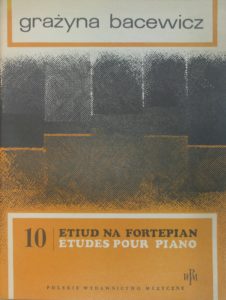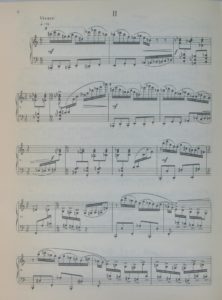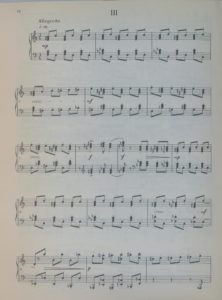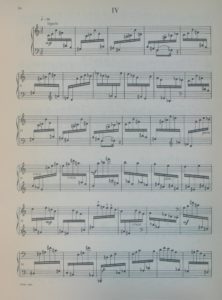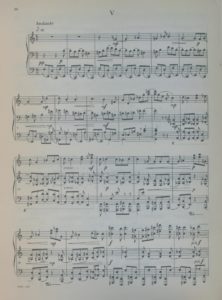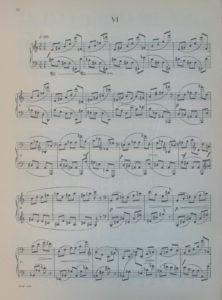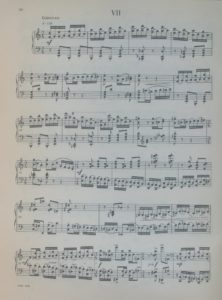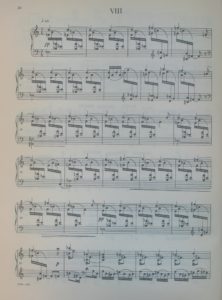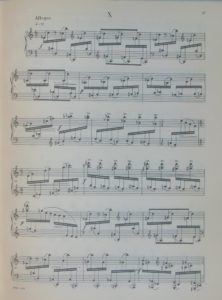When asked by Stefan Kisielewski in 1960, which of her piano works she appreciated the most, Grażyna Bacewicz replied: Sonata No. 2 and 10 Etudes. The latter was written in 1956 and shortly after the premiere was hailed as a natural continuation of the tradition of Chopin and Szymanowski as well as Liszt, Debussy, Bartók and Prokofiev. The first performer of the pieces, Regina Smendzianka [Regina Smendzianka, “Grażyna Bacewicz – fortepianowe Opera Omnia”, Warsaw 1989], described them in 1989 in the following manner:
Traditional notation, traditional approach to the instrument as well as the use of the reprise form expand the range of analogies between Grażyna Bacewicz’s etudes and works of this type by her predecessors. Apart from that, however, Grażyna Bacewicz’s Etudes are a new, stylistically different link in the chain of etude literature for piano: they pose technical problems differently and contain new textural problems.
Henryk Schiller wrote about the Etudes in the booklet of a recording featuring Regina Smendzianka as follows:
Each of them serves to develop a specific pianistic skill: be it fluent execution of passages, or playing of dyads, third or fourth chords. The collection – of ‘exercises in one fashion’, to use Chopin’s phrase – although comprising ten elements with different technical and expressive profiles, makes up as a whole a homogenous formal architecture in which Etudes no. 6 and 10 constitute climaxes, while the slowly developing Etudes no. 5 and 8 play the role of lyrical intermezzi, as it were.
It is worth quoting here an excerpt from Teresa Świercz’s paper [Teresa Świercz, “Problemy rytmu w 10 etiudach na fortepian Grażyny Bacewicz” Gdańsk 1975] devoted mainly to the problem of metre and rhythms in the etudes:
The main problem of the compositional technique in the etudes is the organisation of movement. This stems from the technical premises of the etude as a genre as well as stylistic features of Grażyna Bacewicz as a composer. (…) Movement in Grażyna Bacewicz’s 10 Etudes for piano is characterised by features typical of motor rhythm. I mean here the uniform rhythmic course stemming from the superiority of the rhythmic value selected for a given etude as well as the repeatability of a constant movement formula. In every etude we can distinguish a number of formal fragments. Their distinction is determined by differences in the internal organisation of the material. These are mainly changes in accentuation with the movement cell and general interval outline of the melodic formula remaining constant.
An ideal example of such an approach to technical problems is Etude 1 (Allegro non troppo 2/4). It is characterised by melodic-rhythmic uniformity and constancy of the pattern, identical for both hands, with slight modifications in the middle part. The basis for the development is a four-note, monorhythmic pendular figure with a constant – over a certain section – base note and changing notes moving back and forth between the base notes. The shape of the figure undergoes slight modifications, also moving in space, while the unevenly placed accents stressing the upper notes of this “pendulum” create a clear melodic line.
Greater metric, rhythmic and textural variety can be found in Etude 2 (Vivace, 6/8), although in it, too, the keystone of the form is a figure repeated from time to time and comprising a figurative cell and a chordal cell.
Etude 3 (Allegro, 3/4) is very interesting – a kind of toccata built on monorhythmic, staccato chordal movement. Repeated phrases are built of alternately changed chords with a remarkable harmony.
Another monorhythmic piece is Etude 4 (c=96, 3/8) based on semiquaver figurations with constant change of registers, already in the basic figure consisting of six semiquavers.
Etude 5 (Andante, 6/8) is the first of the lyrical-dramatic intermezzi mentioned by Henryk Schiller. The composer, perhaps slightly influenced by Debussy and his Preludes, introduces here another system for the right hand, in which the main voice is notated. The monorhythmic nature of Etude 6 (c=180), based on uniform quaver movement, is made more interesting by alternating metre (3/2 2/4).
Etude 7 (Giocoso) is an example of quasi-layered polymetry, as Teresa Świercz put it. With a fairly uniform (over long sections) presentation of a similar cell comprising four quavers, the first and third of which are dyads, the left hand is shifted by one quaver. This causes a divergence in accentuation suggesting a polymetric arrangement in a uniform metre of 2/4 for both layers.
Etude 8 (q= 69, 2/4) is another “lyrical intermezzo”, with the outer parts clearly drawing on Debussy’s piano texture and a toccata-like middle part, a reflection of which also appears towards the end.
Etude 9 (Presto, 4/4) is based on a homogeneous triplet figuration of the right hand, additionally supported by the left hand. At some point a change takes place and there also appears convergent and divergent triplet movement of both hands.
The whole is crowned with Etude 10 (Allegro). Homogeneous quaver movement framed by a six-note base cell has a shimmering form achieved by arranging the structure on various sound planes, changing slurring and accentuation. The metre changes more often than in the previous etudes. The final chord of G major in the right hand, supported by an A-E fifth with the note A being doubled in the left hand, tells us a lot about the harmonic specificity of the whole cycle.
The premiere of 10 Concert Etudes took place on 21 May 1957 in Kraków at a concert organised by PWM Edition and the Polish Composers’ Union. The performer was Regina Smendzianka. The same pianist performed the Etudes in 1958, during the Warsaw Autumn International Festival of Contemporary Music. Before that second performance the artist received a letter from the composer with laconic, often funny performance suggestions. Here are some fragments of the letter:
Dear Regina, will I be very importunate, if I briefly repeat my requests concerning the Etudes? I do hope you will not be offended. The first is “banged away” (I can’t find a better word), but you do understand me, don’t you? It is seemingly schoolish and austere, but in order for the accents to be better, I would like this winding ribbon, which these two-bar structures are, e.g. the first two, to be played more gently, in one breath, as it were. (…). The second with quite a lot of verve, especially the chords (e.g. bars 3 and 4). Coda from piano, but with a very large crescendo until the very end. (…) The third one – not too fast! The fourth faster and not espressivo. This is very important for me. Simply flying notes and the impression is to be achieved by moving from register to register, by constant movement against the background of which we find these rhythmic flourishes. The fifth. These three planes are important. The culmination – large crescendo and even a bit of avvivando; then we will achieve this pp, which should really be marked pppp. The sixth at great speed and with a lot of tension. The seventh went very well. In all these rhythmic pursuits the 9th should be played very precisely rhythmically at the end, for it to develop more. The tenth – at maximum speed.
- 10 Concert Etudes for piano, PWM score, cover
- 10 Concert Etudes for piano, PWM score, no. 1
- 10 Concert Etudes for piano, PWM score, no. 2
- 10 Concert Etudes for piano, PWM score, no. 3
- 10 Concert Etudes for piano, PWM score, no. 4
- 10 Concert Etudes for piano, PWM score, no. 5
- 10 Concert Etudes for piano, PWM score, no. 6
- 10 Concert Etudes for piano, PWM score, no. 7
- 10 Concert Etudes for piano, PWM score, no. 8
- 10 Concert Etudes for piano, PWM score, no. 9
- 10 Concert Etudes for piano, PWM score, no. 10
